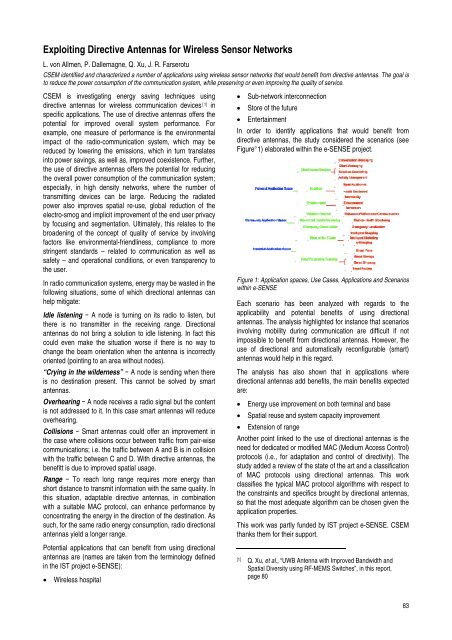research activities in 2007 - CSEM
research activities in 2007 - CSEM
research activities in 2007 - CSEM
Create successful ePaper yourself
Turn your PDF publications into a flip-book with our unique Google optimized e-Paper software.
Exploit<strong>in</strong>g Directive Antennas for Wireless Sensor Networks<br />
L. von Allmen, P. Dallemagne, Q. Xu, J. R. Farserotu<br />
<strong>CSEM</strong> identified and characterized a number of applications us<strong>in</strong>g wireless sensor networks that would benefit from directive antennas. The goal is<br />
to reduce the power consumption of the communication system, while preserv<strong>in</strong>g or even improv<strong>in</strong>g the quality of service.<br />
<strong>CSEM</strong> is <strong>in</strong>vestigat<strong>in</strong>g energy sav<strong>in</strong>g techniques us<strong>in</strong>g<br />
directive antennas for wireless communication devices [1] <strong>in</strong><br />
specific applications. The use of directive antennas offers the<br />
potential for improved overall system performance. For<br />
example, one measure of performance is the environmental<br />
impact of the radio-communication system, which may be<br />
reduced by lower<strong>in</strong>g the emissions, which <strong>in</strong> turn translates<br />
<strong>in</strong>to power sav<strong>in</strong>gs, as well as, improved coexistence. Further,<br />
the use of directive antennas offers the potential for reduc<strong>in</strong>g<br />
the overall power consumption of the communication system;<br />
especially, <strong>in</strong> high density networks, where the number of<br />
transmitt<strong>in</strong>g devices can be large. Reduc<strong>in</strong>g the radiated<br />
power also improves spatial re-use, global reduction of the<br />
electro-smog and implicit improvement of the end user privacy<br />
by focus<strong>in</strong>g and segmentation. Ultimately, this relates to the<br />
broaden<strong>in</strong>g of the concept of quality of service by <strong>in</strong>volv<strong>in</strong>g<br />
factors like environmental-friendl<strong>in</strong>ess, compliance to more<br />
str<strong>in</strong>gent standards – related to communication as well as<br />
safety – and operational conditions, or even transparency to<br />
the user.<br />
In radio communication systems, energy may be wasted <strong>in</strong> the<br />
follow<strong>in</strong>g situations, some of which directional antennas can<br />
help mitigate:<br />
Idle listen<strong>in</strong>g − A node is turn<strong>in</strong>g on its radio to listen, but<br />
there is no transmitter <strong>in</strong> the receiv<strong>in</strong>g range. Directional<br />
antennas do not br<strong>in</strong>g a solution to idle listen<strong>in</strong>g. In fact this<br />
could even make the situation worse if there is no way to<br />
change the beam orientation when the antenna is <strong>in</strong>correctly<br />
oriented (po<strong>in</strong>t<strong>in</strong>g to an area without nodes).<br />
“Cry<strong>in</strong>g <strong>in</strong> the wilderness” − A node is send<strong>in</strong>g when there<br />
is no dest<strong>in</strong>ation present. This cannot be solved by smart<br />
antennas.<br />
Overhear<strong>in</strong>g − A node receives a radio signal but the content<br />
is not addressed to it. In this case smart antennas will reduce<br />
overhear<strong>in</strong>g.<br />
Collisions − Smart antennas could offer an improvement <strong>in</strong><br />
the case where collisions occur between traffic from pair-wise<br />
communications; i.e. the traffic between A and B is <strong>in</strong> collision<br />
with the traffic between C and D. With directive antennas, the<br />
benefitt is due to improved spatial usage.<br />
Range − To reach long range requires more energy than<br />
short distance to transmit <strong>in</strong>formation with the same quality. In<br />
this situation, adaptable directive antennas, <strong>in</strong> comb<strong>in</strong>ation<br />
with a suitable MAC protocol, can enhance performance by<br />
concentrat<strong>in</strong>g the energy <strong>in</strong> the direction of the dest<strong>in</strong>ation. As<br />
such, for the same radio energy consumption, radio directional<br />
antennas yield a longer range.<br />
Potential applications that can benefit from us<strong>in</strong>g directional<br />
antennas are (names are taken from the term<strong>in</strong>ology def<strong>in</strong>ed<br />
<strong>in</strong> the IST project e-SENSE):<br />
• Wireless hospital<br />
• Sub-network <strong>in</strong>terconnection<br />
• Store of the future<br />
• Enterta<strong>in</strong>ment<br />
In order to identify applications that would benefit from<br />
directive antennas, the study considered the scenarios (see<br />
Figure°1) elaborated with<strong>in</strong> the e-SENSE project.<br />
Figure 1: Application spaces, Use Cases, Applications and Scenarios<br />
with<strong>in</strong> e-SENSE<br />
Each scenario has been analyzed with regards to the<br />
applicability and potential benefits of us<strong>in</strong>g directional<br />
antennas. The analysis highlighted for <strong>in</strong>stance that scenarios<br />
<strong>in</strong>volv<strong>in</strong>g mobility dur<strong>in</strong>g communication are difficult if not<br />
impossible to benefit from directional antennas. However, the<br />
use of directional and automatically reconfigurable (smart)<br />
antennas would help <strong>in</strong> this regard.<br />
The analysis has also shown that <strong>in</strong> applications where<br />
directional antennas add benefits, the ma<strong>in</strong> benefits expected<br />
are:<br />
• Energy use improvement on both term<strong>in</strong>al and base<br />
• Spatial reuse and system capacity improvement<br />
• Extension of range<br />
Another po<strong>in</strong>t l<strong>in</strong>ked to the use of directional antennas is the<br />
need for dedicated or modified MAC (Medium Access Control)<br />
protocols (i.e., for adaptation and control of directivity). The<br />
study added a review of the state of the art and a classification<br />
of MAC protocols us<strong>in</strong>g directional antennas. This work<br />
classifies the typical MAC protocol algorithms with respect to<br />
the constra<strong>in</strong>ts and specifics brought by directional antennas,<br />
so that the most adequate algorithm can be chosen given the<br />
application properties.<br />
This work was partly funded by IST project e-SENSE. <strong>CSEM</strong><br />
thanks them for their support.<br />
[1] Q. Xu, et al., “UWB Antenna with Improved Bandwidth and<br />
Spatial Diversity us<strong>in</strong>g RF-MEMS Switches”, <strong>in</strong> this report,<br />
page 80<br />
83








